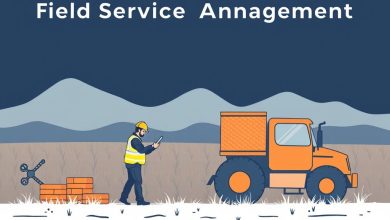Field Service Management with Embedded Help for Technicians A Guide to Efficient Support

Introduction
Field Service Management (FSM) is a critical component of many industries, particularly in sectors such as HVAC, electrical work, plumbing, and home maintenance. As technology advances, FSM systems have evolved to incorporate various features that enhance efficiency and productivity. One significant improvement in recent years is the integration of embedded help systems specifically designed for technicians in the field.
Embedded help systems provide real-time assistance to technicians during job execution, ensuring they have quick access to information and solutions when needed. This feature addresses common challenges faced by field service professionals, including limited knowledge of specific products or procedures, time constraints, and the need for immediate problem-solving.
In this article, we will explore the concept of Field Service Management with Embedded Help for Technicians, its benefits, implementation strategies, and best practices for maximizing its effectiveness.
- Benefits of Embedded Help Systems in Field Service Management
- Improved Efficiency
- Enhanced Knowledge Base
- Consistency in Service Delivery
- Reduced Training Time
- Improved Customer Experience
- Implementation Strategies for Embedded Help Systems in Field Service Management
- Best Practices for Maximizing Effectiveness of Embedded Help Systems
- Conclusion
Benefits of Embedded Help Systems in Field Service Management
Improved Efficiency
One of the primary advantages of embedded help systems in FSM is the enhancement of operational efficiency. By providing instant access to relevant information and troubleshooting guides, technicians can resolve issues more quickly and accurately. This leads to faster completion of jobs, reduced downtime, and increased customer satisfaction.
Enhanced Knowledge Base
Embedded help systems serve as a centralized repository of knowledge, containing detailed product information, installation instructions, and troubleshooting guides. This eliminates the need for technicians to constantly refer to separate manuals or search for information online, saving valuable time and reducing errors.
Consistency in Service Delivery
By standardizing the information available to technicians through embedded help systems, companies can ensure consistency in service delivery across all locations and teams. This reduces variability in the quality of service provided and helps maintain brand standards.
Reduced Training Time
New technicians can benefit from embedded help systems by accessing detailed guidance and step-by-step instructions for various tasks. This accelerates the learning curve and allows them to become productive sooner, reducing training costs and time.
Improved Customer Experience
With quick access to accurate information and solutions, technicians can address customer concerns more effectively. This leads to higher customer satisfaction scores and increased loyalty towards the company.
Implementation Strategies for Embedded Help Systems in Field Service Management
To successfully implement an embedded help system in your FSM platform, consider the following strategies:
- Customize Content: Tailor the help content to your specific products and services. Ensure that it covers all aspects of job execution, including setup, troubleshooting, and maintenance.
- Integrate with Existing Systems: Seamlessly integrate the embedded help system with your existing FSM software to ensure smooth workflow and minimize disruption to current processes.
- Provide Search Functionality: Implement a robust search function that allows technicians to quickly find relevant information based on keywords or job-specific details.
- Include Multimedia Resources: Incorporate videos, images, and diagrams alongside textual information to cater to different learning styles and make complex concepts easier to understand.
- Regular Updates: Maintain and update the help content regularly to reflect changes in products, procedures, and industry best practices.
- User Feedback Mechanism: Implement a feedback system where technicians can suggest improvements or report inaccuracies in the help content.
- Accessibility Features: Ensure that the embedded help system is accessible on mobile devices, allowing technicians to access information anywhere in the field.
- Role-Based Access: Implement role-based access control to ensure that only authorized personnel can view sensitive information related to specific products or services.
Best Practices for Maximizing Effectiveness of Embedded Help Systems
To get the most out of your embedded help system, consider the following best practices:
- Standardize Terminology: Use consistent terminology across all help content to avoid confusion and improve searchability.
- Organize Content Hierarchically: Structure the help content in a logical hierarchy, making it easy for technicians to navigate and find relevant information quickly.
- Include Troubleshooting Guides: Provide comprehensive troubleshooting guides that cover common issues and their solutions.
- Offer Context-Sensitive Help: Allow technicians to access context-sensitive help while performing specific tasks, providing relevant information at the point of need.
- Implement Localization: If operating in multiple regions, localize the help content to account for regional differences in products, regulations, and terminology.
- Conduct Regular Audits: Periodically review and audit the help content to ensure accuracy, relevance, and alignment with current products and procedures.
- Provide Multi-Language Support: If necessary, offer support for multiple languages to cater to a diverse workforce or international operations.
Conclusion
Field Service Management with Embedded Help for Technicians represents a significant advancement in the field service industry. By providing instant access to relevant information and solutions, these systems enhance operational efficiency, improve knowledge retention, and contribute to better customer experiences.
As technology continues to evolve, we can expect further innovations in FSM platforms, potentially incorporating AI-driven assistance, augmented reality interfaces, and even voice-controlled help systems. However, regardless of future developments, the core principle of providing technicians with readily accessible, context-specific information will remain crucial for maintaining high-quality service delivery.
For field service managers looking to optimize their operations and improve technician performance, implementing an embedded help system should be a top priority. By doing so, they can streamline workflows, reduce training times, and ultimately deliver superior service to their customers while maintaining competitive edge in the market.



